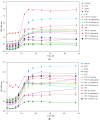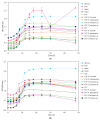Aqueous Extracts of Fermented Macrofungi Cultivated in Oilseed Cakes as a Carbon Source for Probiotic Bacteria and Potential Antibacterial Activity
- PMID: 37512561
- PMCID: PMC10386005
- DOI: 10.3390/metabo13070854
Aqueous Extracts of Fermented Macrofungi Cultivated in Oilseed Cakes as a Carbon Source for Probiotic Bacteria and Potential Antibacterial Activity
Abstract
Plant biomass colonized by macrofungi can contain molecules with bioactive properties with applications to human/animal health. This work aimed to verify antibacterial activities from aqueous extracts from oil seed cakes of Jatropha curcas (JSC) and cottonseed (CSC), fermented by macrofungi for probiotic bacteria cultivation. Coriolopsis sp., Tyromyces sp., Panus lecomtei, and Pleurotus pulmonarius were cultivated in solid and submerged media. The aqueous extract of unfermented JSC was more efficient than glucose for the growth of all probiotic bacteria. Extracts from four macrofungi fermented in CSC favored Lactobacillus acidophilus growth. In solid fermentation, macrofungi extracts cultivated in JSC favored Bifidobacterium lactis growth. All fungi extracts showed more significant growth than carbohydrates among the four probiotic bacteria evaluated. Regarding antimicrobial activities, no fungal extract or bacterial supernatant showed a more significant inhibition halo for enteropathogenic bacteria than ampicillin (control). Extracts from P. lecomtei and Coriolopsis sp. in CSC showed inhibition halos for Salmonella enterica. Supernatants from L. acidophilus, B. lactis, and Lactobacillus rhamnosus resulted in more significant inhibition of Staphylococcus aureus than the control, which indicates possible antimicrobial activity. Unfermented JSC supernatant showed better results for bacterial growth, while supernatants and aqueous extracts from CSC fermentation can be used for probiotic bacteria culture.
Keywords: antimicrobial activities; biodetoxification; fermentation; macrofungi bioactive; oil seed cake.
Conflict of interest statement
The authors declare no conflict of interest.
Figures









References
-
- Adebayo E.A., Oloke J.K., Ayandele A.A., Adegunlola C.O. Phytochemical, antioxidant and antimicrobial assay of mushroom metabolite from Pleurotus pulmonarius–LAU 09 (JF736658) J. Microbiol. Biotechnol. Res. 2012;2:366–374.
-
- Aida F.M.N.A., Shuhaimi M., Yazid M., Maaruf A.G. Mushroom as a potential source of prebiotics: A review. Trends Food Sci. Technol. 2009;20:567–575. doi: 10.1016/j.tifs.2009.07.007. - DOI
-
- Cheung P.C. Mini-review on edible mushrooms as source of dietary fiber: Preparation and health benefits. Food Sci. Hum. Wellness. 2013;2:162–166. doi: 10.1016/j.fshw.2013.08.001. - DOI
LinkOut - more resources
Full Text Sources
Molecular Biology Databases

